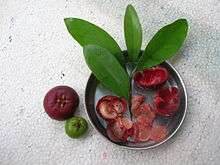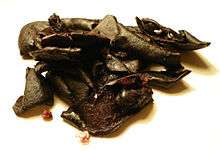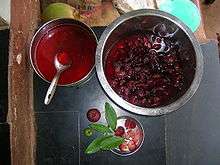Garcinia indica
| Garcinia indica | |
|---|---|
 | |
| Kokum fruits, seeds, pulp and rinds.jpg | |
| Scientific classification | |
| Kingdom: | Plantae |
| Clade: | Angiosperms |
| Clade: | Eudicots |
| Clade: | Rosids |
| Order: | Malpighiales |
| Family: | Clusiaceae |
| Genus: | Garcinia |
| Species: | G. indica |
| Binomial name | |
| Garcinia indica | |
Garcinia indica, a plant in the mangosteen family (Clusiaceae), commonly known as kokum, is a fruit-bearing tree that has culinary, pharmaceutical, and industrial uses.
The genus Garcinia, belonging to the family Clusiaceae, includes about 200 species found in the Old World tropics, mostly in Asia and Africa. Garcinia indica is indigenous to the Western Ghats region of India located along the western coast of the country. Of the 35 species found in India, 17 are endemic. Of these, seven are endemic to the Western Ghats, six in the Andaman and Nicobar Islands and four in the northeastern region of India.
Garcinia indica is found in forest lands, riversides and wastelands. These plants prefer evergreen forests, but sometimes they also thrive in areas with relatively low rainfall. It is also cultivated on a small scale. It does not require irrigation, spraying of pesticides or fertilizers.
Uses
Culinary uses

The fresh fruit can be preserved with sugar to make bright-red squash that is diluted with water and bottled for sale as a beverage.
The outer cover of fruit is dried in the sun to get aamsul or kokam. It is also known as bhirand in Konkani, muragalu in Kannada, punarpuli in Tulu and kaatampi in Malayalam. It is used as a staple souring agent typically in Goan cuisine and some parts of Maharashtra and Karnataka.[1] Kokum yields a peculiar flavour and blackish red colour. As a souring agent, it is used as an alternative to tamarind in curries and other dishes from South india.[2] It is also used in cuisine from Gujarat, where it is frequently used to add flavor and tartness to dal (lentil soup) for flavor balance, and parts of South India. It is extensively used in Assamese cuisine in many dishes like "masor tenga" or sour fish curry and "tenga dali" or sour dal. It is also used as a cure for upset stomach and colds. A few dry pieces are soaked in water for some time and then the pieces are mashed in the water itself and can be taken in whole.

Kokum squash or kokum concentrate is used in preparing a drink (sherbet) which is bright red in colour.
Further, the extract/ concentrate of this fruit is called aagal in Konkani and Marathi. It is added during the preparation of solkadhi, which may also include coconut milk, coriander and garlic.
Industrial uses
The seed of Garcinia indica contains 23–26% oil, which remains solid at room temperature. It is used in the preparation of chocolate and sugar confectionery.[3]
Medical applications
The oily extract called Kokam has many medicinal uses.It is used in ointments and suppositories.It is applied on skin to stop inflammation.It is also used for treating certain cases of diarrhoea and TB (Phthisis pulmonalis). (.[2]
The rind of the fruit is a good source of hydroxycitric acid (HCA), a chemical with therapeutic value against obesity.[2]
Other uses
The tree is ornamental, with a dense canopy of green leaves and red-tinged, tender, young leaves.
References
- ↑ Ron Herbst; Sharon Tyler Herbst (2015). The Deluxe Food Lover's Companion, 2nd edition. Barron's Educational Series. ISBN 978-1-4380-7621-8.
- 1 2 3 K. V. Peter (Editor); V.K. Raju (author); M. Reni (author) (17 August 2001). Handbook of Herbs and Spices. Elsevier. pp. 207–213. ISBN 978-1-85573-645-0.
- ↑ Kanes K. Rajah (2002). Fats in Food Technology. CRC Press. p. 167. ISBN 978-0-8493-9784-4.
External links
| Wikimedia Commons has media related to Garcinia indica. |